- HOME
- Enzyme List
- CNI-311 CREATININE DEIMINASE
CNI-311
CREATININE DEIMINASE from Microorganism

PREPARATION and SPECIFICATION
| Appearance | White amorphous powder, lyophilized | |
|---|---|---|
| Activity | GradeⅢ 10 U/mg-solid or more (containing approx. 30 % of stabilizer) |
|
| Contaminants | Creatinine amidohydrolase | ≤1.0×10-2 % |
| Creatine amidinohydrolase | ≤1.0×10-2 % | |
| Urease | ≤1.0×10-2 % | |
| NADH oxidase | ≤1.0×10-2 % | |
| NH4+ | ≤1.0×10-2 μg/u | |
| Stabilizer | Mannitol | |
PROPERTIES
| Stability | Stable at −20 ℃ for at least one year (Fig.1) |
|---|---|
| Molecular weight | approx. 260,000 |
| Isoelectric point | 4.4 |
| Michaelis constant | 3.5×10-3 M (Creatinine) |
| Structure | 6 subunits per enzyme molecule |
| Inhibitors | Ag+,Hg2+,o-phenanthroline,monoiodoacetate |
| Optimum pH | 8.5−9.5(Fig.3) |
| Optimum temperature | 65-75 ℃(Fig.4) |
| pH Stability | pH 7.0−11.0 (30 ℃, 20 hr)(Fig.5) |
| Thermal stability | below 65 ℃ (pH 7.5, 1 hr)(Fig.6) |
| Effect of various chemicals | (Table 1) |
APPLICATIONS
This enzyme is useful for enzymatic determination of creatinine in combination with glutamate dehydrogenase (GTD-211, GTD-209, GTD-309), in clinical analysis.
ASSAY
Principle

Glutamate dehydrogenase (NADP+ dependent; GLDH): Deaminating L-glutamate-NADP oxidoreductase (EC 1.4.1.4.)
The elimination of NADPH is measured at 340 nm by spectrophotometry.
Unit definition
One unit causes the formation of one micromole of ammonia (the oxidation of micromole of NADPH) per minute under the conditions detailed below.
Method
Reagents
| A. Creatinine solution | 50 mM (565.5 mg creatinine/100 mL of 50 mM K-phosphate buffer, pH7.5) |
|---|---|
| B. NADPH solution | 3.0 mM (27.2mg NADPH・Na4・4H2O/10 mL of 50 mM K-phosphate buffer, pH7.5)(Should be prepared fresh) |
| C. α-Ketoglutarate solution | 10 mM (14.6mg α-Ketoglutaric acid/10 mL of 50 mM K-phosphate buffer, pH7.5)(Should be prepared fresh) |
| D. GIDH solution | ca.1,000 U/mL[Dilute Toyobo GradeⅡ (Tris-HCl buffer solution, free from ammonia to ca.1,000 U/mL with H2O.)] |
| E. Enzyme diluent | 50 mM K-phosphate buffer, pH 7.5 |
Procedure
1.Prepare the following reaction mixture in a cuvette (d = 1.0cm) and equilibrate at 37℃ for about 5 minutes.
| 2.4 mL | Substrate solution | (A) |
|---|---|---|
| 0.3 mL | NADPH solution | (B) |
| 0.3 mL | α-Ketoglutarate solution | (C) |
| 0.05 mL | GIDH solution | (D) |
| Concentration in assay mixture | |
|---|---|
| Potassium phosphate buffer | 49 mM |
| Creatinine | 38 mM |
| α-Ketoglutarate | 0.95 mM |
| NADPH | 0.29 mM |
| GIDH | ca.16 U/mL |
2.Add 0.10 mL of the enzyme solution* and mix by gentle inversion.
3.Record the decrease in optical density at 340 nm against water for 3〜4 minutes in a spectrophotometer thermostated at 37 ℃, and calculate the ΔOD per minute from the initial linear portion of the curve (ΔOD test).
At the same time, measure the blank rate using the same method as the test except that the enzyme diluent is added instead of the enzyme solution (ΔOD blank).
*Dissolve the enzyme preparation in ice-cold enzyme diluent (E) and dilute to 0.15−0.4 U/mL with the same buffer, immediately before the assay.
Calculation
Activity can be calculated by using the following formula :
Volume activity (U/mL) =
-
ΔOD/min (ΔOD test−ΔOD blank)×Vt×df
6.22×1.0×Vs
= ΔOD/min×5.06×df
Weight activity (U/mg) = (U/mL)×1/C
| Vt | : Total volume (3.15 mL) |
| Vs | : Sample volume (0.10 mL) |
| 6.22 | : Millimolar extinction coefficient of NADH (cm2/micromole) |
| 1.0 | : Light path length (cm) |
| df | : Dilution factor |
| C | : Enzyme concentration in dissolution (c mg/mL) |
REFERENCES
1)J.Szulmajster; Biochim.Biophys.Acta, 30, 154 (1958).
2)T.Uwajima and O.Terada; Agr.Biol.Chem., 40, 1055 (1976).
3)T.Uwajima and O.Terada; Agr.Biol.Chem., 41, 339 (1977).
4)D.Tsuru; Rinsho Kensa, 22, 1331 (1978).
5)T.W.Esders and S.Y.Lynn; J.Biol.Chem., 260, 3915 (1985).
Table 1. Effect of Various Chemicals on Creatinine deiminase
[The enzyme dissolved in 50mM Tris-HCl buffer, pH 7.5 (2 U/mL) was incubated at 25℃ for 2hr with each chemical. The residual activity was assayed according to the routine method described above.]
-
Chemical Concn.(mM) Residual activity(%) None ー 100 Metal salt 1.0 MgCl2 103.8 CaCl2 100.6 Ba(OAc)2 105.7 FeCl3 5.0 CoCl2 108.2 MnCl2 179.0 ZnSO4 100.0 Cd(OAc)2 143.0 NiCl2 103.2 CuSO4 2.1 Pb(OAc)2 87.3 AgNO3 1.1 HgCl2 1.6 2-Mercaptoethanol 1.0 96.8 PCMB 0.1 91.1 -
Chemical Concn.(mM) Residual activity(%) MIA 1.0 0.6 NEM 1.0 86.1 IAA 1.0 60.1 Hydroxylamine 1.0 86.1 EDTA 2.0 96.2 o-Phenanthroline 1.0 0.7 α,α′-Dipyridyl 0.1 100.6 Borate 5.0 98.7 NaF 1.0 100.6 NaN3 1.0 99.4 Triton X-100 1.0 % 95.6 Brij 35 0.1 % 83.5 Span 20 0.5 % 103.2 Na-cholate 0.5 % 100.0 SDS 0.5 % 101.0 DAC 0.5 % 81.8
-
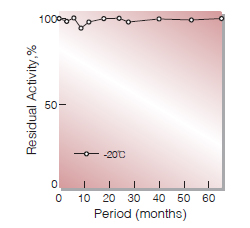
Fig.1. Stability (Powder form)
(kept under dry conditions)
-
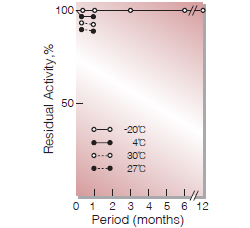
Fig.2. Stability (Powder form)
(kept under dry conditions)
-
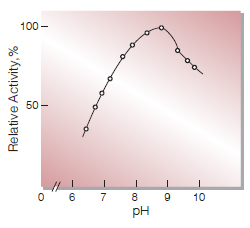
Fig.3. pH-Activity
37℃ in Britton-Robinson buffer; The activity was assayed by the indophenol method.3)
-
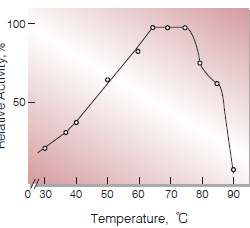
Fig.4.Temperature activity
in 50mM K-phosphate buffer, pH 7.5; The acitivity was assayed by the indophenol method.3)
-
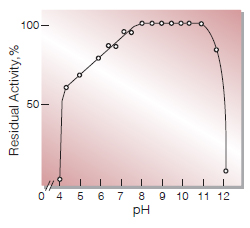
Fig.5. pH-Stability
30℃,20hr-treatment with Britton-Robinson buffer
-
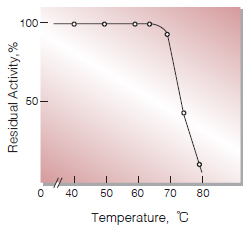
Fig.6. Thermal stability
1hr-treatment with 50mM K-phosphate buffer, pH7.5
活性測定法(Japanese)
1. 原理

NADPHの消失量を340nmにおける吸光度の変化で測定する。
2.定義
下記条件下で1分間に1マイクロモルのアンモニアを生成する酵素量を1単位 (U)とする。
3.試薬
- 50mMクレアチニン溶液(565.5mgのクレアチニンを50mM K-phosphate buffer, pH7.5 100 mLに溶解する)(用時調製)
- 3.0mM NADPH溶液(27.2mg NADPH・Na4・4H2Oを50mM K-phosphate buffer, pH7.5 10 mLに溶解する)(用時調製)
- 10mM α-ケトグルタル酸溶液(14.6mgのα-ケトグルタル酸を50mM K-phosphate buffer, pH7.5 10 mLに溶解する)
- グルタミン酸脱水素酵素(GIDH)溶液〔Tris-HCl緩衝液(アンモニアを含有しない東洋紡製GIDHは本活性測定に適す)を約1,000 U/mLに蒸留水で希釈して使用する〕
酵素溶液:酵素標品を予め氷冷した50mMK-phosphate buffer, pH7.5で溶解し,分析直前に同緩衝液で0.15〜0.4U/mLに希釈する。
4.手順
1.下記反応混液をキュベット(d=1.0cm)に調製し,37℃で約5分間予備加温する。
| 2.4 mL | 基質溶液 | (A) |
| 0.3 mL | NADPH溶液 | (B) |
| 0.3 mL | α-ケトグルタル酸溶液 | (C) |
| 0.05 mL | GIDH溶液 |
2.酵素溶液0.1mLを添加し,ゆるやかに混和後,水を対照に37℃に制御された分光光度計で340nmの吸光度変化を3〜4分間記録し,その初期直線部分から1分間あたりの吸光度変化を求める(ΔODtest)。
3.盲検は反応混液1に酵素溶液の代りに酵素希釈液(50mM K-phosphate buffer, pH 7.5)を0.1mL加え,上記同様に操作を行って1分間当りの吸光度変化を求める(ΔODblank)。
5.計算式
U/mL =
-
ΔOD/min (ΔOD test−ΔOD blank)×3.15(mL)×希釈倍率
6.22×1.0×0.10(mL)
| = ΔOD/min×5.06×希釈倍率 | |
| U/mg | =U/mL×1/C |
| 6.22 | : NADPHのミリモル分子吸光係数(cm2/micromole) |
| 1.0 | : 光路長(cm) |
| C | : 溶解時の酵素濃度(c mg/mL) |
CONTACT
-
For inquiries and cosultations regarding our products, please contact us through this number.
- HEAD OFFICE+81-6-6348-3843
- Inquiry / Opinion
